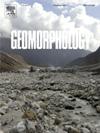Tentative quantification of the provenances of aeolian sands in the Wulanbuhe Desert of northwestern China: Insights from geochemical and grain size analysis of sediment samples
IF 3.1
2区 地球科学
Q2 GEOGRAPHY, PHYSICAL
引用次数: 0
Abstract
Identifying the provenance of aeolian sand is crucial to unraveling the formation and evolution processes of dunes commonly occurring in arid and semi-arid regions. This study presents comprehensive grain size and geochemical data for the mobile dunes (n = 22), vegetated dunes, i.e., dunes stabilized or semi-stabilized by vegetation (n = 26), and fluvial sand samples (n = 10) in the Wulanbuhe (a.k.a. Ulan Buh) Desert (WD) of northwestern China. Major-elemental data and the Al2O3 - CaO*+Na2O+K2O - SiO2 (A-CNK-Si) diagram indicates that dune sands have undergone sedimentary sorting during aeolian transport, although chemical weathering was weak. Spatial variations in grain size and geochemical characteristics within the WD dune sands are not systematically observed, indicating a heterogeneous mixture of materials from diverse sources. Based on the end-members mixing model, this study found differences in the sand sources between the mobile and vegetated dunes in the WD. The bedrock detritus from the surrounding mountains is a dominant source (60 %) of the mobile dune sands in the WD, followed by the paleo-lacustrine deposits from the desert hinterlands (24 %) and the sediments of alluvial fans from the upwind areas (16 %). In contrast, the sands of vegetated dunes were derived from the bedrock detritus (48 %), alluvial fans from the upwind side (32 %), and paleo-lacustrine deposit (20 %), respectively. Our findings confirm that the presence of vegetation on the dune surface influences sediment grain-size characteristics, which in turn affects aeolian erosion and deposition processes, leading to variations in sand source materials.
乌兰布河沙漠风沙物源的初步定量研究——来自地球化学和沉积物粒度分析的启示
确定风成沙的来源对于揭示干旱半干旱地区常见沙丘的形成和演化过程至关重要。本文收集了乌兰布河沙漠流动沙丘(n = 22)、植被沙丘(即被植被稳定或半稳定的沙丘)(n = 26)和河流沙(n = 10)的综合粒度和地球化学数据。主要元素数据和Al2O3 - CaO*+Na2O+K2O - SiO2 (A-CNK-Si)图表明,沙丘砂在风运过程中经历了沉积分选,但化学风化作用较弱。WD沙丘砂的粒度和地球化学特征的空间变化没有系统地观察到,表明来自不同来源的物质的非均匀混合。基于端元混合模型,研究发现移动沙丘与植被沙丘在沙源上存在差异。西部移动沙丘砂的主要来源为周边山地的基岩碎屑(60%),其次是沙漠腹地的古湖相沉积(24%)和逆风地区的冲积扇沉积(16%)。植被沙丘砂主要来自基岩碎屑(48%)、逆风侧冲积扇(32%)和古湖相沉积(20%)。我们的研究结果证实,沙丘表面植被的存在影响沉积物粒度特征,进而影响风蚀和沉积过程,导致沙源物质的变化。
本文章由计算机程序翻译,如有差异,请以英文原文为准。
求助全文
约1分钟内获得全文
求助全文
来源期刊

Geomorphology
地学-地球科学综合
CiteScore
8.00
自引率
10.30%
发文量
309
审稿时长
3.4 months
期刊介绍:
Our journal''s scope includes geomorphic themes of: tectonics and regional structure; glacial processes and landforms; fluvial sequences, Quaternary environmental change and dating; fluvial processes and landforms; mass movement, slopes and periglacial processes; hillslopes and soil erosion; weathering, karst and soils; aeolian processes and landforms, coastal dunes and arid environments; coastal and marine processes, estuaries and lakes; modelling, theoretical and quantitative geomorphology; DEM, GIS and remote sensing methods and applications; hazards, applied and planetary geomorphology; and volcanics.
 求助内容:
求助内容: 应助结果提醒方式:
应助结果提醒方式:


